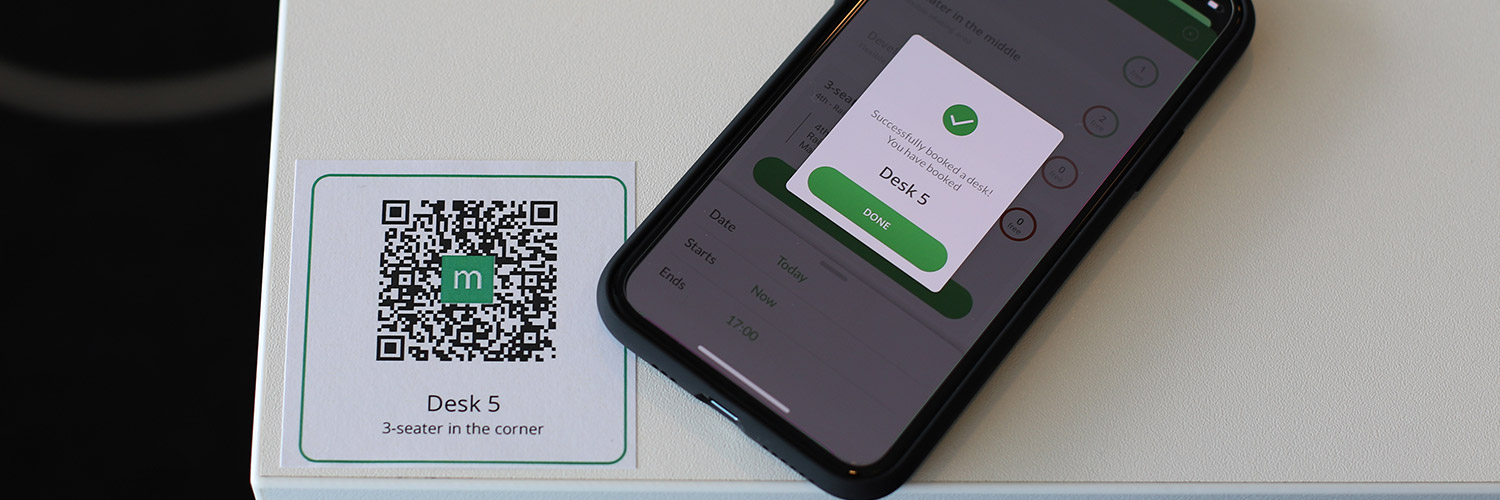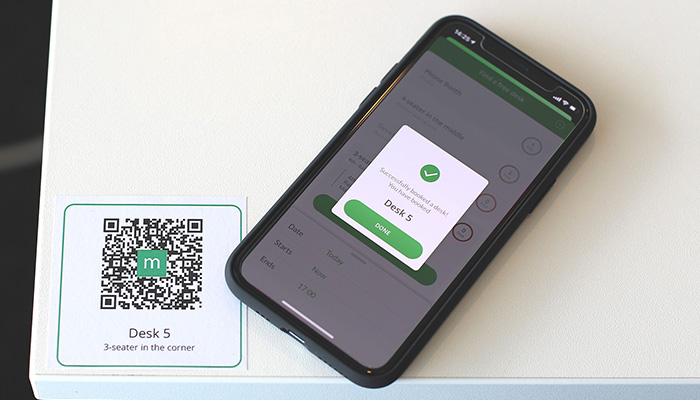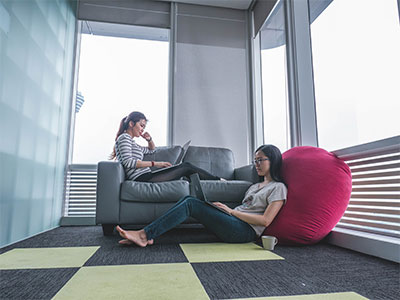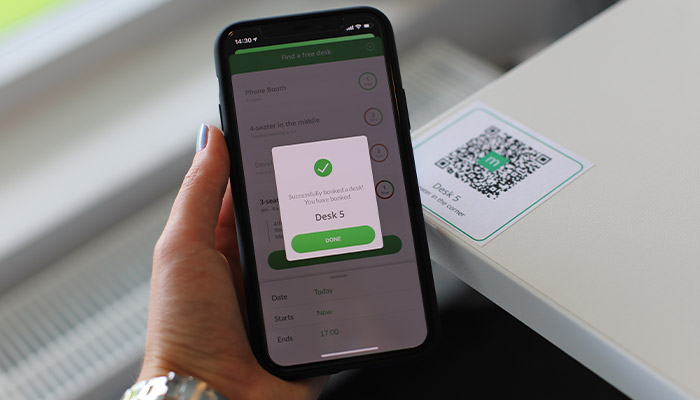
It's time you get acquainted with hot desking.
Modern workplaces are all about creating environments for collaboration and productivity, while at the same time trying to increase ROI on real estate. Is it a dead equation or can it be done? The answer is yes, and the solution is hot desking.
The concept hot desking has been around for a while, but during the covid-19 pandemic, it became a hot topic (pun intended). As businesses all over the world were looking for ways to safely return to the office, hot desking became one of the main solutions. Coincidentally, hot desking can solve a critical issue for many organizations –the utilization of workspaces.
In this in-depth look, we discuss the benefits, how you get started, and last but not least what tools you need. Let’s go!
If you picture an office in your mind, what do you see? Maybe an open area with desks, some meeting rooms, a lunchroom, and some lounge furniture? Or a big building with one office or cube for each employee, different floors for different departments, a fancy lobby and a canteen? Or the contemporary option, different settings for different types of work mixed with meeting areas for different types of meetings?
Hot desking has long been associated with activity-based workplaces and offices with a focus on flexible working. This is about to change. In reality, all of the examples above benefit from it. But what is hot desking?
Simply put, the meaning of hot desking is the practice of sharing desks in an office. If we look at Wikipedia, this is what it says:
”Hot desking (sometimes called "non-reservation-based hoteling") is an office organization system which involves multiple workers using a single physical work station or surface during different time periods.[1] The "desk" in the name refers to an office desk being shared by multiple office workers on different shifts as opposed to each staff member having their own personal desk.”
Hot desking is known by many names. If you’re unfamiliar to hot desking, maybe you recognize these?
Some make a distinction between hot desking and desk hoteling. It is most common to refer to hot desking as an ad-hoc action, while hoteling refers to booking desks in advance. The expression “hoteling” refers to booking a desk as you normally book a hotel room. We don’t separate the expressions in this text, instead, we see them as synonyms.
Free address is just what it sounds like – desks that are not assigned to anyone and therefore free to use for hot desking. Just another synonym.
Reverse hot desking is a practice were people that have an assigned desk make it available for the days they’re not in the office. This is for example perfect for businesses that have a lot of guest workers or consultants. For example, when an employee is out for some days, a guest worker can use the employee’s desk instead of sitting at home or in a remote location.
Hot desking might not be as new as you imagine. The term actually derives from the US Navy and the similar-sounding expression “hot racking”. The sailors worked and slept in shifts and shared sleeping bunks. By doing so, the bunks always remained hot from the last person using them.
Experiments with hot desking started in the ’80s and ’90s with mixed results. The inspiration also came from hotels and the practice of booking rooms (yes, desk hoteling). However, due to the lack of technology and management, the first attempts didn’t gain widespread recognition.
The market has grown dramatically and there are several sophisticated desk management solutions on the market. It’s estimated it will grow even more as companies work to find new ways of working after the Covid-19 pandemic.
Even before the pandemic, hot desking popularity had increased. There are a lot of benefits to sharing desks instead of having one desk devoted to one person. Let's go through them!
Real estate and office space are one of the biggest expenses for businesses. Just think about it – we often associate big, successful corporations with their grand big city buildings and campuses. That rent or mortgage is not cheap. At the same time, studies have shown that most desks stand empty around 50% of a working week. That means that much of the space that companies pay big bucks for is left unused.
It’s, therefore, no surprise that one of the greatest benefits of hot desking is that it can trim those expenses significantly. Hot desking lets you shrink your footprint to the number of desks actually being used. Reclaimed space can instead be used for more or larger meeting rooms, phone booths, lounge areas, or whatever your business needs.
We’ve established that reducing the number of desks in your office gives you more space to work with. Your company may, of course, choose to move to a smaller office, but don’t forget that hot desking is an excellent way to rethink your workplace design in any quarter.
It’s no secret that workplace design influences employee satisfaction. A workplace built for supporting employee needs and flexibility can do wonders for creativity and performance. If you’re interested in how you can adapt your new spaces and transform them, check out our additional resources on how to rethink your workplace!

|

|
Companies are constantly looking for new ways to increase collaboration between employees. Hot desking is collaborative by nature. The idea is to let employees decide where they do their best work. Some days it might be from a quiet area, some days in an open landscape, or some days from home. They will likely move around and therefore interact with different people across the company.
What we also have learned during the Covid-19 pandemic is that people miss the small interactions with their colleagues when they work from home. Research shows that one of the top motivators for people to return to the office is to be social again. Hot desking has the added benefit of enabling communication between people outside of their team – which is often one of the main challenges we face in collaboration and communication.
Hot desking work demands a clean desk policy. This means that no personal belongings can be left on any desk at the end of the day. Your employees need to bring and remove their stuff when they arrive and leave. The result? A much tidier workplace! Use some of that extra space to add lockers so your employees can stash their things. Some smart companies have even designed locker systems fitted with portable carrying trays (think portable toolbox) that can be grabbed from the locker and transported to the desk for the day.
An unexpected bonus is that tidier workspaces actually increase safety in the workplace. It’s incredibly common for employees to leave notes with passwords and documents with sensitive information on their desks. It drives security teams crazy! Having a clean desk policy virtually erases that possibility.
If you’re even a little interested in workplace trends, you must have read about the hybrid workplace. This model is all about flexibility. Employees should be able to work both from home and the office without difficulty. Companies worldwide are striving to raise morale and employee retention by adopting flexible, dynamic hybrid workplaces.
Hot desking brings autonomy and improved collaboration and communication. Giving employees the freedom to choose where they want to work by simply booking a desk is a game-changer.

Hot desking is scalable. One of the pains that many scaling businesses face is having to move to new, larger offices to accommodate their growing workforce. While new employees are a sign of a thriving business – finding a new lease can be a major headache.
Flexible work and hot desking enable your business to grow without the stress of relocating. By adapting your workplace, you can focus on finding the right location and not the right square meters. This is a real win for startups that likely are more sensitive to higher costs.
Hot desking is not a workplace design in itself. It can however be a part of your workplace design. A traditional office design accounts for one person per desk, but hot desking accommodates multiple employees at different times – making it possible to play around with different areas and environments. But first – how many desks do you actually need?
Hot desking is not simply keeping your existing desks and converting them to hot desks. The goal is to utilize desks better by reducing their number. Fewer bodies in the office at one time, more space and separation.
But how do you know how many desks you need? Turn to your employees. What are their preferences? How many days do they want to come into the office? Consider any parameters your company needs to include. Some employees may want to keep their own, assigned desk and come into the office every day. Make a plan for incorporating both fixed and hot desks by surveying the team.
We like to categorize employees into three groups for desk usage. By doing so, you will get a better idea of how many desks you need:
Mobile employees are employees who don’t spend more than 20% of their time at a desk. For example, consultants or contract employees who have a range of different tasks and activities during their workdays. As with the flex employee, the mobile employee enjoys a flexible workplace.
When you know how big your different groups are, you’ll have a pretty good understanding of how occupied your workplace will be during the course of a week. For example, if you have 50 employees –it might look like this:

There are many different hot desk setups, and that’s the fun part. So many possibilities! Let’s go through two of them to give you some inspiration!
Activity-based working, or ABW, is a business strategy that gives employees the freedom to choose where, when, and how they work depending on the requirements of the specific task. Spaces should be designed to provide opportunities for a range of workplace activities from focused and intense work (quiet areas) to informal meetings.
When it comes to ABW, the workspace is a combination of the open floor plan and the cell office layout, together with other office features added in based on need. For many businesses, this leads to true workspace optimization focused on providing space for both high focus, and low focus activities, as well as solo and collaborative tasks. This means that the total space may include sections with desks or tables, but also can have rooms for solitary, high focus collaborative work where you can lock yourself in with a group of people and not disturb others.
In these workspaces, companies often create other areas for lounges, where low focus work and informal or impromptu meetings can happen. Putting all of this together – activity-based workplaces are perfect for hot desking, allowing people to choose their seating based on their tasks. We have lots of additional resources on activity-based working if you're interested in knowing more!
The open-plan office has gained a rather bad reputation. Not entirely unfair, as studies have actually shown that a fully open design can cause higher levels of stress. If an open floor plan is to be successful, it should be combined with spaces that allow focused work, like a quiet area or pods for privacy. Most importantly, companies who use the open-plan office should have a flexible working policy.
Flexible working refers to the practice of letting employees have more freedom to decide where and how they do their work. Some models also allow employees to work when they want instead of having a set time. Some days it might be from the office, some days from home, or entirely remote. Companies that only have an open plan could really benefit from a flexible setup as it allows employees to sit at home when they need to focus, which often becomes a struggle in the open plan. In that case, the open-plan office becomes ideal for hot desking!

|

|
Introducing new tech to an organization with old habits and traditions can be challenging. It doesn’t have to be, but it could. For you, it might be crystal clear that your organization needs to adapt to hot desking, but for your co-worker it might feel overwhelming or unnecessary. Therefore, to make sure the digital transformation is successful, it’s important that you have a comprehensive approach to change management.
Three short tips on how to facilitate change:
Like anything, when not executed properly, hot desking can become complicated for employees. To avoid frustrated employees – lookout for these pitfalls:
People need to be able to sit quietly and work. Missing out on quiet space is the most common problem when discussing problematic open setups, and also the most common complaint from employees.
Lacking the right technology can render the simplest idea useless. Get ahead of the game by investing in both hot desking tools and other software as meeting room booking solutions. Don’t forget to update your desk with new docking stations and power outlets.
Hot desking goes hand in hand with not having personal stuff on the desk. After each day, employees must take their things with them before they go home. To make this happen, there should be lockers or other forms of storage for any needed “desk kits”.
Try to imagine how your coworkers would react to the idea of hot desking – would they be positive and excited or the total opposite? The first reaction doesn't need to be a foretaste of how the actual outcome will be. But it will mean that you may have to prepare arguments and answers to any upcoming thoughts and questions.
How are your employees supposed to make desk reservations if there is no booking tool in place? Get your hands on a hot desking system that is simple to use and easy to manage. Our solution Meetio Desk lets you get started within minutes. Whatever your solution of choice, we will go through the process of choosing a desk booking tool below.
The primary reason transitions to hot desking fail is due to insufficient technology or no technology at all. For example, if you just tell your employees that they can choose whatever desk they want without making any changes in your layout – they will probably use their old, assigned desk. This may be from fear of “taking” someone else’s desk or just comfort. By adding a clear, easy-to-use desk scheduling software you will avoid creating an environment of conflict or unspoken resentment.
Hot desking tech solutions help your business implement, manage and succeed with a flexible workplace. Go or a tool that is easy to use and easy to set up and you will be off to a very good start!
The market for desk booking solutions has grown during the latest years, and it can be hard to know what to choose. Because of our vast experience of working with companies implementing hot desking, we suggest you look for these features.
What happens when something is too complex or too complicated? Well, most people give up on it. That's not what you want with a new workplace tool. Go for a solution that is easy to use for everyone!
What is the thing people carry with them at all times? Their smartphone, of course. Find a hot desk solution that comes with a smartphone app. This enables your employees to do desk scheduling on the go, from wherever they are.
The hot desk booking app should support scheduling desks in advance and ad-hoc booking, adding both control and freedom.
People aren’t perfect and often forget to cancel a booking they can’t show up for. The check-in feature is critical to overcoming wasted space from “ghosted” reservations. If someone fails to check-in to their reserved desk or space within a (customizable) set timeframe, the booking is dropped and space freed up. Not only does this help you most effectively use your resources, but in terms of contact tracing, it will help you prevent inaccurate attendance reports.
See who's in the office and where they are located in the app. Perfect when you want to find a seat close to your team or a specific coworker.
With software that uses interactive floor-plan maps, you can easily locate your booked desk and other available spaces. You can also see where there are free seats and meeting rooms to book
Get better use of your workspaces without putting in a lot of effort. Less job for you, less trouble for your organization.
Starting small and building is a great strategy for a lot of things, and a desk booking tool is no exception. You may need to add on new desks as the pandemic eases. Make therefore sure to choose an office desk reservation system that lets you add new licenses without a big investment.
A central, cloud-based, and user-friendly administration tool is your best friend. Our solutions come with Meetio Admin, a management tool that you easily set up and manage.
We recommend that you choose a hot-desking solution that connects to your calendar system. If you want to add on more integrated workplace solutions in the future, it will be a lot smoother process if everything is connected to the same system.
Why waste time and energy on tricky setup processes when you can get started in under three minutes? Meetio’s desk booking software comes with an administration tool that even non-technical people can use.
No one likes software that is complicated to deploy and implement. The same goes for hot desk tools.
Hardware can be both expensive and ill-fitted to your workplace. Go for a solution that is flexible and gives you the ROI that you want. You shouldn’t be forced to go with hardware just because it’s the only option.
Do you need to add more desks or are half of them going unused? With smart workplace analytics, you will understand how your office is performing, how it’s utilized, and if you need to make any changes. In the end, this helps you get a better ROI and use of your space.
No one likes tools that create more issues than it reduces, either. An elegant solution is not complex, it's simple.

By now you know quite a lot about hot desking. But before we leave you to plan your new hot desking strategy, here are some control questions that you might want to take into consideration:
We wish you good luck with your project! If you have any questions, need help on getting started or anything else, we are here to help!
Meetio AB/Logitech Nordics AB
Hamngatan 4
211 22, Malmö
Sweden
Magnus Ladulåsgatan 3
SE-118 65 Stockholm
Sweden
Sweden: +46-(0)10-101 95 60